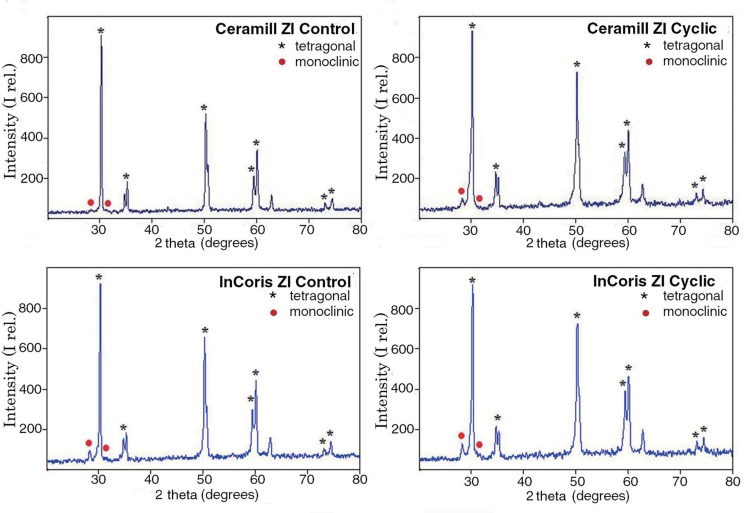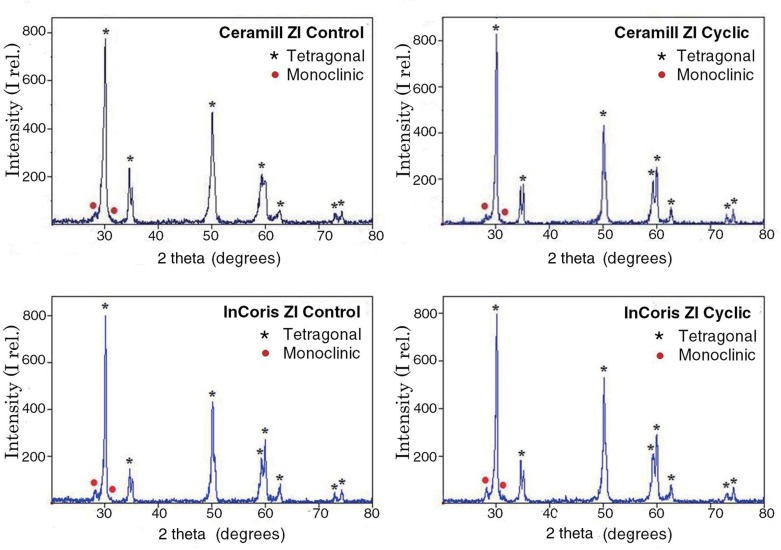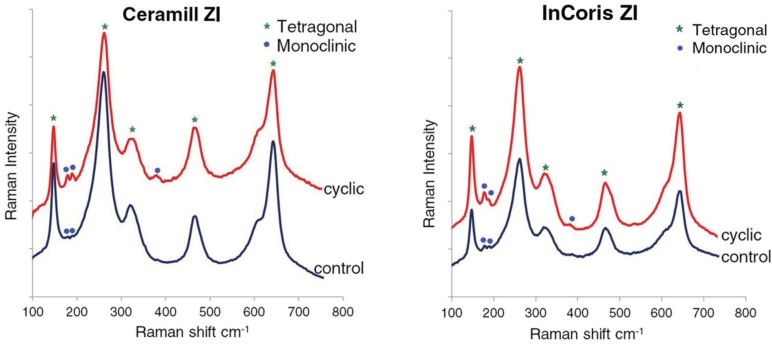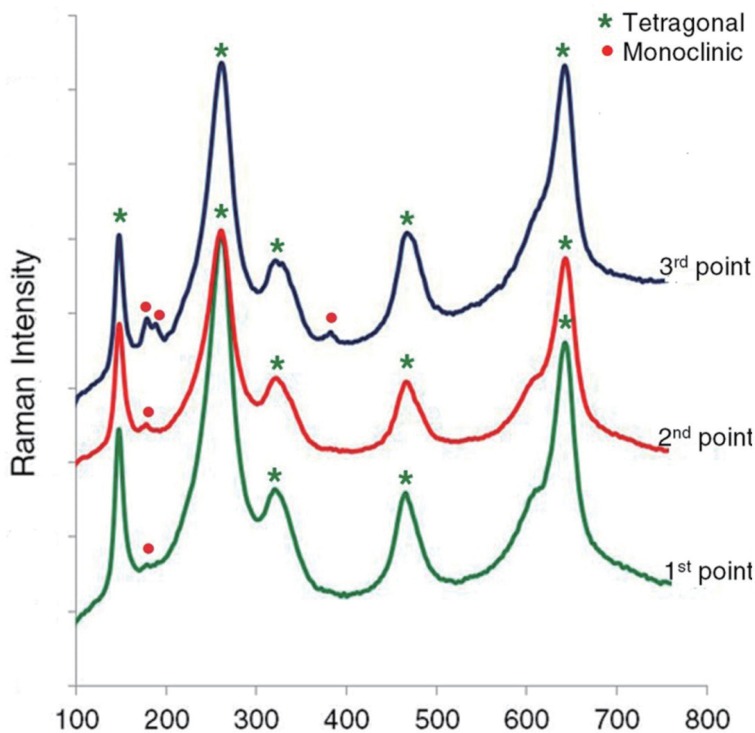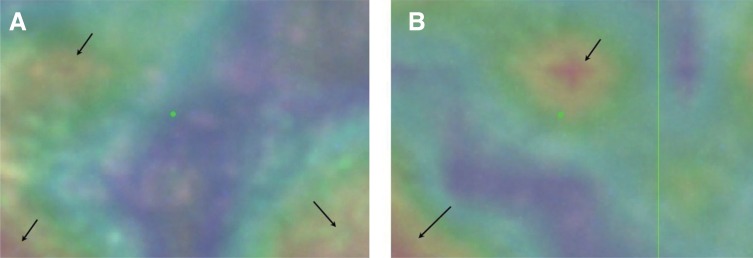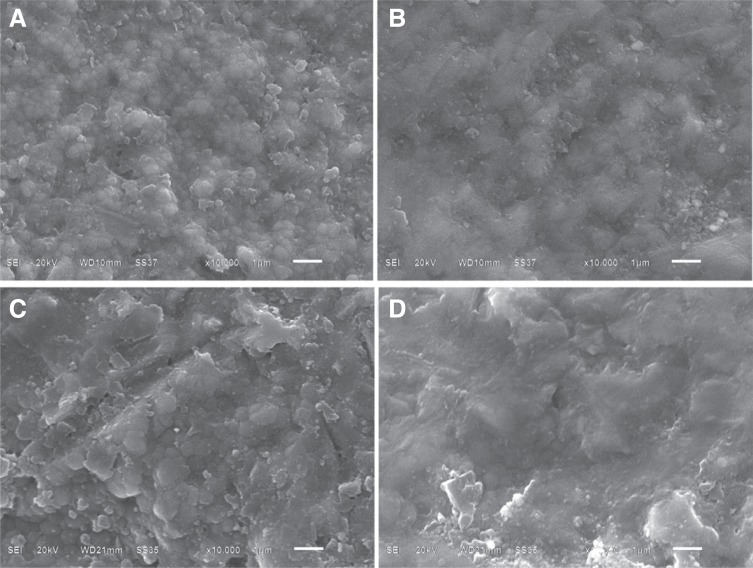J Adv Prosthodont.
2019 Oct;11(5):253-261. 10.4047/jap.2019.11.5.253.
Ageing assessment of zirconia implant prostheses by three different quantitative assessment techniques
- Affiliations
-
- 1Faculty of Dentistry, Mahidol University, Rachathevi, Bangkok, Thailand. kallaya.sup@mahidol.ac.th
- 2Chemical and Biological Analysis Section, Technical Support for Material Analysis Division, National Metal and Materials Technology Center, Pathum Thani, Thailand.
- 3Department of Science Service, Ministry of Science and Technology, Ratchathewi, Bangkok, Thailand.
- KMID: 2462108
- DOI: http://doi.org/10.4047/jap.2019.11.5.253
Abstract
- PURPOSE
To evaluate the influence of cyclic loading on phase transformation of zirconia abutments and to compare the effectiveness of three different quantitative ageing assessment techniques.
MATERIALS AND METHODS
Thirty two Y-TZP prostheses fabricated from two brands, InCoris ZI and Ceramill ZI, were cemented to titanium bases and equally divided into two subgroups (n=8): control group without any treatment and aged group with cyclic loading between 20 N and 98 N for 100,000 cycles at 4 Hz in distilled water at 37℃. The tetragonal-to-monoclinic phase transformation was assessed by (i) conventional x-ray diffraction (XRD), (ii) micro x-ray diffraction (µXRD), and (iii) micro-Raman spectroscopy. The monoclinic-phase fractions (M%) were compared by two-way ANOVA.
RESULTS
InCoris Zi presented significantly higher M% than Ceramill Zi in both control and aged groups (P<.001). Both materials exhibited significant phase transformation with monoclinicphase of 1 to 3% more in aged groups than controls for all thre e assessment techniques. The comparable M% was quantified by both µXRD and XRD. The highest M% was assessed with micro-Raman.
CONCLUSION
Cyclic loading produced significant phase transformation in tested Y-TZP prostheses. The micro-Raman spectroscopy could be used as an alternative to XRD and µXRD.
Keyword
Figure
Reference
-
1. Andersson B, Odman P, Lindvall AM, Lithner B. Single-tooth restorations supported by osseointegrated implants: results and experiences from a prospective study after 2 to 3 years. Int J Oral Maxillofac Implants. 1995; 10:702–711. PMID: 8530173.2. Kimura H, Horng CJ, Okazaki M, Takahashi J. Oxidation effects on porcelain-titanium interface reactions and bond strength. Dent Mater J. 1990; 9:91–99. PMID: 2098213.
Article3. Gomes AL, Montero J. Zirconia implant abutments: a review. Med Oral Patol Oral Cir Bucal. 2011; 16:e50–e55. PMID: 20526253.
Article4. Denry I, Kelly JR. State of the art of zirconia for dental applications. Dent Mater. 2008; 24:299–307. PMID: 17659331.
Article5. Kelly JR, Denry I. Stabilized zirconia as a structural ceramic: an overview. Dent Mater. 2008; 24:289–298. PMID: 17624420.
Article6. Chevalier J, Gremillard L, Virkar AV, Clarke DR. The tetragonal-monoclinic transformation in zirconia: Lessons learned and future trends. J Am Ceram Soc. 2009; 92:1901–1920.
Article7. Chevalier J, Cales B, Drouin JM. Low-temperature aging of Y-TZP ceramics. J American Ceram Soc. 1999; 82:2150–2154.
Article8. Hummer CD 3rd, Rothman RH, Hozack WJ. Catastrophic failure of modular zirconia-ceramic femoral head components after total hip arthroplasty. J Arthroplasty. 1995; 10:848–850. PMID: 8749771.
Article9. #2 FPSNS. Hip implant recall because of potential fracture problems. 2002. http://www.fda.gov/downloads/Safety/FDAPatientSafetyNews/UCM417762.pdf.10. Flinn BD, deGroot DA, Mancl LA, Raigrodski AJ. Accelerated aging characteristics of three yttria-stabilized tetragonal zirconia polycrystalline dental materials. J Prosthet Dent. 2012; 108:223–230. PMID: 23031728.
Article11. Kohorst P, Borchers L, Strempel J, Stiesch M, Hassel T, Bach FW, Hübsch C. Low-temperature degradation of different zirconia ceramics for dental applications. Acta Biomater. 2012; 8:1213–1220. PMID: 22138551.
Article12. Cattani-Lorente M, Scherrer SS, Ammann P, Jobin M, Wiskott HW. Low temperature degradation of a Y-TZP dental ceramic. Acta Biomater. 2011; 7:858–865. PMID: 20854937.
Article13. Kim HT, Han JS, Yang JH, Lee JB, Kim SH. The effect of low temperature aging on the mechanical property & phase stability of Y-TZP ceramics. J Adv Prosthodont. 2009; 1:113–117. PMID: 21165265.14. Flinn BD, Raigrodski AJ, Singh A, Mancl LA. Effect of hydrothermal degradation on three types of zirconias for dental application. J Prosthet Dent. 2014; 112:1377–1384. PMID: 25277037.
Article15. Sailer I, Fehér A, Filser F, Gauckler LJ, Lüthy H, Hämmerle CH. Five-year clinical results of zirconia frameworks for posterior fixed partial dentures. Int J Prosthodont. 2007; 20:383–388. PMID: 17695869.16. Zembic A, Philipp AO, Hämmerle CH, Wohlwend A, Sailer I. Eleven-year follow-up of a prospective study of zirconia implant abutments supporting single all-ceramic crowns in anterior and premolar regions. Clin Implant Dent Relat Res. 2015; 17:e417–e426. PMID: 25180473.
Article17. ISO 14801. Dentistry - Implants - Dynamic fatigue test for endosseous dental implants. 2nd ed. Geneva; Switzerland: International Standards Organization (ISO);2007. https://www.iso.org/standard/41034.html.18. Munoz-Tabares AMa, Anglada MJ. Quantitative analysis of monoclinic phase in 3Y-TZP by raman spectroscopy. J Am Ceram Soc. 2010; 93:1790–1795.19. Cotes C, Arata A, Melo RM, Bottino MA, Machado JP, Souza RO. Effects of aging procedures on the topographic surface, structural stability, and mechanical strength of a ZrO2-based dental ceramic. Dent Mater. 2014; 30:e396–e404. PMID: 25244926.
Article20. Basílio Mde A, Cardoso KV, Antonio SG, Rizkalla AS, Santos Junior GC, Arioli Filho JN. Effects of artificial aging conditions on yttria-stabilized zirconia implant abutments. J Prosthet Dent. 2016; 116:277–285. PMID: 26996934.21. Egilmez F, Ergun G, Cekic-Nagas I, Vallittu PK, Lassila LV. Factors affecting the mechanical behavior of Y-TZP. J Mech Behav Biomed Mater. 2014; 37:78–87. PMID: 24887645.
Article22. Lange FF, Dunlop GL, Davis BI. Degradation during aging of transformation-toughened ZrO2-Y2O3 materials at 250°C. J Am Ceram Soc. 1986; 69:237–240.23. Schmauder S, Schubert H. Significance of internal stresses for the martensitic transformation in Yttria-stabilized tetragonal zirconia polycrystals during degradation. J Am Ceram Soc. 1986; 69:534–540.
Article24. Stawarczyk B, Ozcan M, Hallmann L, Ender A, Mehl A, Hämmerlet CH. The effect of zirconia sintering temperature on flexural strength, grain size, and contrast ratio. Clin Oral Investig. 2013; 17:269–274.
Article25. Deville S, Gremillard L, Chevalier J, Fantozzi G. A critical comparison of methods for the determination of the aging sensitivity in biomedical grade yttria-stabilized zirconia. J Biomed Mater Res B Appl Biomater. 2005; 72:239–245. PMID: 15654702.
Article26. He BB, Preckwinkel U. X-ray optics for two-dimensional diffraction. Adv in X-ray Anal. 2002; 45:332–337.27. He BB. Introduction to two-dimensional X-ray diffraction. Powder Diffraction. 2003; 18:71–85.
Article28. He BB. Microdiffraction using two-dimensional detectors. Powder Diffraction. 2004; 19:110–118.
Article29. Wulfman C, Sadoun M, Chapelle ML. Interest of raman spectroscopy for the study of dental material: The zirconia material example. IRBM. 2010; 31:257–262.
Article30. Clarke DR, Adar F. Measurement of the crystallographically transformed zone produced by fracture in ceramics containing tetragonal zirconia. J Am Ceram Soc. 1982; 65:284–288.
Article31. Kim B, Hahn J, Han K. Quantitative phase analysis in tetragonal-rich tetragonal/monoclinic two phase zirconia by Raman spectroscopy. J Mater Sci Lett. 1997; 16:669–671.
Article32. Muñoz-Tabares J, Jiménez-Piqué E, Anglada M. Subsurface evaluation of hydrothermal degradation of zirconia. Acta Materialia. 2011; 59:473–484.
Article33. Siarampi E, Kontonasaki E, Andrikopoulos KS, Kantiranis N, Voyiatzis GA, Zorba T, Paraskevopoulos KM, Koidis P. Effect of in vitro aging on the flexural strength and probability to fracture of Y-TZP zirconia ceramics for all-ceramic restorations. Dent Mater. 2014; 30:e306–e316. PMID: 24993809.
Article34. Fillit R, Homerin P, Schafer J, Brugas H, Thevenot F. Quantitative XRD analysis of zirconia-toughened alumina ceramics. J Mater Sci. 1987; 22:3566–3570.
Article35. Wulfman C, Djaker N, Dupont N, Ruse D, Sadoun M, Chapelle ML. Raman spectroscopy evaluation of subsurface hydrothermal degradation of zirconia. J Am Ceram Soc. 2012; 95:2347–2351.
Article36. Fontijn-Tekamp FA, Slagter AP, Van Der Bilt A, Van ‘T Hof MA, Witter DJ, Kalk W, Jansen JA. Biting and chewing in overdentures, full dentures, and natural dentitions. J Dent Res. 2000; 79:1519–1524. PMID: 11005738.
- Full Text Links
- Actions
-
Cited
- CITED
-
- Close
- Share
- Similar articles
-
- Assessment of the fit of zirconia-based prostheses fabricated with two different scan methods
- Clinical Evaluation of Lithium Disilicate Pressed Zirconia and Monolithic Zirconia in Posterior Implant-Supported Prostheses
- Implant-Supported Fixed Dental Prostheses with New Retention Type Using Zirconia Ball and Nickel-Titanium Spring
- Mounting and utilization of provisional prostheses on master cast for the fabrication of fixed implant-supported prostheses: a case report
- A review of biocompatibility of zirconia and bioactivity as a zirconia implant: In vivo experiment


